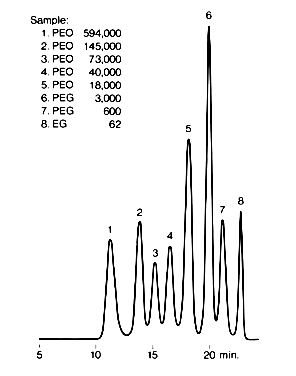
Polyethylene Glycol | Uses, Suppliers, and Specifications | PharmaCentral | Materials and Knowledge Platform

Poly(ethylene glycol) (PEG) and poly(vinyl chloride) (PVC) are examples of polymers, large organic molecules composed of repeating smaller units covalently bonded together. Polymers have very different properties depending (in part) on their

Poly(Ethylene Oxide) and Poly(Ethylene Glycol) Standards (SB-804 HQ) | Shodex/ HPLC Columns, Detectors, Standards

Polystyrene-block-poly(ethylene oxide)-block-polystyrene: A New Synthesis Method Using Nitroxide-Mediated Polymerization from Poly(ethylene oxide) Macroinitiators and Characterization of the Architecture Formed | Macromolecules

Size distribution of PEG 1000 -PE (10 –5 M), PEG 5000 -PE (10 –5 M) and... | Download Scientific Diagram

Surface Modification of Zinc Oxide Nanoparticles Using Polyethylene Glycol under Microwave Radiation | Scientific.Net

Synthetic schemes for ethoxylation, M-PEG product, V-PEG product and... | Download Scientific Diagram

Safety Assessment of PEGs Cocamine and Related Ingredients as Used in Cosmetics - Ivan Boyer, Christina L. Burnett, Wilma F. Bergfeld, Donald V. Belsito, Ronald A. Hill, Curtis D. Klaassen, Daniel C.

Safety Assessment of PEGs Cocamine and Related Ingredients as Used in Cosmetics - Ivan Boyer, Christina L. Burnett, Wilma F. Bergfeld, Donald V. Belsito, Ronald A. Hill, Curtis D. Klaassen, Daniel C.

Core-shell structured polyethylene glycol functionalized graphene for energy-storage polymer dielectrics: Combined mechanical and dielectric performances - ScienceDirect

PEO(Polyethylene Oxide) | Functional Materials (Relating to Funcitonal Chemicals) | Product Information | SUMITOMO SEIKA CHEMICALS CO.,LTD.

PDF) Suitability of polyethylene glycol for precipitation of monoclonal antibodies— a radiometric study | Jayula Sarnaik - Academia.edu

Poly(ethylene glycol) (PEG) and poly(vinyl chloride) (PVC) are examples of polymers, large organic molecules composed of repeating smaller units covalently bonded together. Polymers have very different properties depending (in part) on their

Safety assessment on polyethylene glycols (PEGs) and their derivatives as used in cosmetic products - ScienceDirect

PDF) Liquid-Liquid Equilibrium of Aqueous Mixtures of Poly(ethylene glycol) with Na2SO4 or NaCl | eric cheluget - Academia.edu








